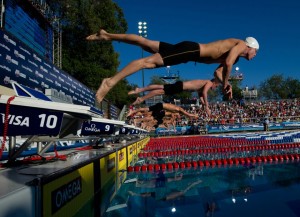Competitive Coach’s Corner – February 2012
Stepping Stones: The Importance of National Level Meets

Every year as we approach our championship season, the buzz on the deck is all about time standards (“cuts”). “How many regional times do I have?”, “Our times are fast enough to score two relays at State!” or “I am three tenths away from the Northwest Sectional cut in my event,” are common conversations every week from Holiday training on through our spring break. These are great conversations for our swimmers and coaches to have, but what does it mean in the larger picture?
To a seasonal or part-time swimmer the greatest accomplishment to achieve on the state level is in the form of a High School State finalist. While this is a great goal and should be an aspiration of every swimmer no matter the commitment level, the truth remains that based on the quality and depth of the high school meet, the level of competition can vary widely at this level. While a time of 53 seconds in the 100 freestyle may qualify for a high school male at some states, that would not qualify in Arizona. Likewise a time of 48 seconds in the 100 free would qualify in the top 10 in Arizona, may not make it into the finals in a state with great depth of swimming such as Florida or Pennsylvania. So where does this leave a swimmer?
Unfortunately, without the proper perspective, it could lead to a distorted view of how great a swimmer’s sense of self could be for better or worse, and an unrealistic view of their marketability in their quest to compete at a collegiate level. For this reason, it is imperative that year-round club swimmers such as yourselves take the opportunity to rise above the view of “eliteness” at the state level and look at the panoramic perspective of our sport at the national level.
Fortunately for USA Swimming club swimmers, our federation has laid out a tier system to see just that; Speedo Sectional Championships, Grand Prix Series, Junior Nationals, Senior Nationals, US Open and finally Olympic Trials. These meets and their corresponding time standards provide an excellent barometer with no age specificity, because in the end, all swimmers compete against their equally fast peers no matter the age from Missy Franklin (16yrs old) to Dara Torres (44yrs old). These time standards also show us where the fastest of the fast should be in each event; such as, if a swimmer considers themselves both a 50 freestyler and a 100 backstroker then he should be 22.59 in the 50 as well as 55.79 in the 100 backstroke, and if one cut is achieved, the other should be within the realm of possibility. Lastly and probably most importantly, the biggest two reasons why these meets are integral to our swimming progression is 1) the ability to go and swim against swimmers of similar ability and 2) recognition by potential collegiate suitors for the future. Stepping up to race a heat of swimmers all going 53 in the 100 backstroke or 47 in the 100 freestyle is simply not something that happens often at the state level, whereas at a tier meet, there could very well be 10 heats of swimmers all going that time. This experience is invaluable not only for the racing aspect, but for the future training and mental motivation that is required to reach the next step on the competitive ladder.
In addition to the competitive advantage of the fast races, our swimmers futures in the sport hinge on that college coach knowing your swimmer and being interested in them for the future. Most college programs simply don’t have the resources or staff to attend any high school or club state meets other than possibly in the state they reside. However, a huge number of college coaches in the country attend Senior Nationals, US Open, and Olympic Trials both as coaches and recruiters, and an equal number and wider variety or programs’ recruiting coaches attend Junior Nationals, Grand Prix Series, and the Speedo Sectional meets. They look at stroke mechanics, number or events, time drops, times, and age. Their date banks are large and deep and all the way down to 8th grade, and they will be back the following year with that list in tow.
Currently these meets are at the cusp of achievement for only a handful of our swimmers; they have been educated on Sectionals and beyond for nearly two years at a time when for many, it seemed like a herculean feat and part of their long-term goals. Now it is becoming a reality. They are setting the trend for where our younger swimmers will be in the future. We are a young team brimming with ability and for many of our swimmers these meets are achievable with the right goals and attitudes in and out of the pool.
For more information regarding the meets mentioned in this article, visit the following website: http://usaswimming.org/DesktopDefault.aspx?TabId=1401&Alias=Rainbow&Lang=en
–Coach Mike




